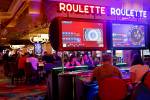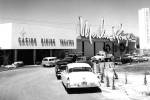Anchor Gaming founder, UNLV benefactor Stan Fulton dies at 86
Stan Fulton, the Anchor Gaming founder and chairman who donated millions of dollars to the University of Nevada, Las Vegas, including a $6.7 million gift to enable the construction of a building bearing his name on campus, died Jan. 4.
He was 86, according to a statement from Sunland Park Racetrack, a New Mexico racetrack he owned.
Fulton, whose namesake building houses UNLV’s International Gaming Institute, was raised in Hancock, Maryland, and attended the University of Maryland.
He left college to serve in the Air Force in the 1950s and later became an entrepreneur, owning an auto parts shop, building cable TV systems and producing electronic components.
His business interests branched into Las Vegas when he built an apartment complex and, in the 1970s, entered gaming.
Fulton’s Fortune Coin developed the first video slot machines, the statement said. Fulton then built a Nevada slot route and founded Anchor Coin, Anchor Gaming’s precursor, in 1989.
Not long after, Anchor ran Colorado casinos and continued to develop video slots. The company developed its most popular game, Wheel of Gold, in December 1995; it let gamblers play the slot game, then spin a secondary wheel for additional payouts. The statement called Wheel of Gold the predecessor to Wheel of Fortune, the superpopular slot machine based on the long-running syndicated television game show.
Marcus Prater, executive director of the Association of Gaming Equipment Manufacturers, called the marriage of Anchor’s Wheel of Gold and International Game Technology’s Wheel of Fortune seismically important and what prompted IGT to eventually acquire Anchor.
“If you look at what ultimately became most successful slot machine of all time (Wheel of Fortune), Mr. Fulton’s innovation, along with his team on Wheel of Gold, and the patent protections that went along with that changed the industry,” Prater said Wednesday. “It was a game everyone wanted to copy but couldn’t without running into legal troubles. It really did change our industry.”
Stepping up for UNLV
In October 2000, the 35,000-square-foot Stan Fulton Building opened on UNLV’s campus on the corner of Flamingo Road and Swenson Street. Fulton’s money financed $5 million in building construction and provided $1.7 million more in scholarship endowments for the university’s honors program.
“It has been the dream of the UNLV International Gaming Institute to one day have its own facility. Mr. Fulton’s generous support will now make that possible,” then-UNLV President Carol Harter told UNLV Magazine for its fall 1996 issue. “We are also delighted that Mr. Fulton, who has made his business and his fortune in the gaming industry, has recognized the need to support gaming education and research, as well as student achievement in all disciplines.”
In a UNLV statement announcing the building’s opening, Fulton said, “This is my way of saying thank you to the gaming industry and the state of Nevada.”
Bo Bernhard, executive director of UNLV’s International Gaming Institute, said former UNLV President Robert Maxson, former Nevada Gaming Commission Chairman Bill Curran and casino industry leaders had long discussed, and dreamed, of having a building to serve as a worldwide center for gaming learning.
Fulton, he said, made it possible.
“It was important to have a building to lead to world of gaming academe,” Bernhard said Wednesday. “We wanted a building to be outward facing to reflect our serving our students and the gaming industry and public community. And Mr. Fulton stepped up.”
International institute
Fulton’s gift, Bernhard said, provided UNLV with an important, neutral nexus for discussing gaming and its complexities. The Fulton Building in recent months, he said, staged the Las Vegas Stadium Authority’s high-level talks on the National Football League’s Oakland Raiders and their planned move to Las Vegas.
And when pictures of silver-and-black-clad Raider advocates were broadcast to the world on media conventional and social, the Fulton Building was frequently the backdrop, he said.
“And because we’re an international institute,” Bernhard added, “we can have regulators from Macau sitting next to officials from Africa discussing gaming policy and convening in this very special space.”
In all, Fulton donated $10 million to the university, a UNLV official said. UNLV Magazine said some of his gifts supported academic scholarships, tennis courts, athletics and the refurbishing of a biology lab. He received the Distinguished Nevadan Award from the University and Community College System of Nevada’s Board of Regents in 1992.
Fulton was also generous beyond Nevada. In October 2000, he gave $5.25 million in cash to construct a student center and 2,000-seat sports arena at Hope International University in Fullerton, California.
New Mexico State University told the Las Cruces Sun-News newspaper on Tuesday that Fulton was the school’s largest single donor, having given more than $17 million for endowed professorships, a football stadium and a university aircraft. The paper said Fulton also contributed to other entities, the city of Sunland Park and the Gadsden Independent School District.
International Game Technology bought Anchor in July 2001 for $1.37 billion in stock and assumed debt. IGT sold Anchor’s slot route to Herbst Gaming in 2003.
Fulton and his family reduced their interest in Anchor to 37 percent from 52 percent in December 1997, unloading 1.8 million shares, valued at $158.7 million. The Wall Street Journal reported. Fulton fully ceded his interest in Anchor in September 2000, when he and his family sold their shares for $306 million.
Fulton is survived by six children and 12 grandchildren. A funeral is scheduled for Friday in Hancock, Maryland.
Contact Matthew Crowley at mcrowley@reviewjournal.com. Follow @copyjockey on Twitter.




























